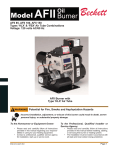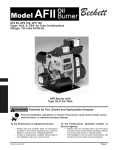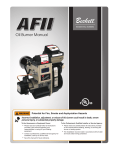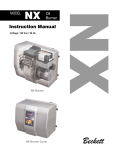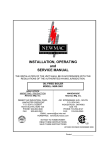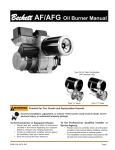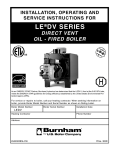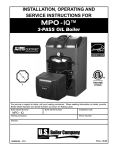Download Beckett AFII 100 Instruction manual
Transcript
AFII Oil Burner Instruction Manual AFII MODEL AFII 85, AFII 100, AFII 150 Types “HLX” & “FBX” air tube combinations Voltage: 120 Vac / 60 Hz AFII burner with type “HLX” air tube Type “FBX” air tube combinations Beckett Beckett Instruction Manual – Model AFII Oil Burner Contents Prepare before installing Verify specifications ……………………………….…………………..…….………….. 3 Be aware of hazard definitions …………….…………….…..………..……………….. 3 Check certifications/approvals ……………………………………..…………………... 3 Notice special requirements ………………….…………...…………..……………….. 3 Prepare burner & site Inspect/prepare installation site ……………………...…………..………………….… 4 Prepare burner ……………………………...…..…………………..…………………… 5 HLX arrangement……………….…………….………………………..………………... 6 FBX arrangement …………………………………….….…………..………………….. 7 Adjust, pipe, & wire burner Mount burner on appliance ………………………………..…………..……………….. 8 Connect fuel lines ………………………………………………………..……………… 8 Wire burner ………………………………………………………………..……………... 8, 9 Startup & adjust burner Startup burner/set combustion ………..……………..….…………..…………………. 10 Set combustion with instruments …………..………….…………..…………………... 10 Service & maintain burner Perform regular maintenance …………………..……….……………..……….……… 10 To replace the blower wheel ………………………..……………….…………………. 10 Replacement parts ………………………………………………………………………. 11 Owner’s information and warranty ………………………………….………….……… 12 Table 1 – Air Tube Combination (ATC) codes AFII AIR TUBE COMBINATION AND FIRING RATE CHART USABLE AIR TUBE LENGTH DIM. “A” (see Fig. 5) 3” 5” 7” 9” ATC Code FIRING RATE RANGE Head AFII 85 AFII 100 AFII 150 Head Design – Adjustable w/ stop screw – typical applications: Wet base boilers HLX30 HLX50 HLX70 HLX90 HB AF2-6 0.40-0.85 gph 0.65-1.00 gph 0.75-1.35 gph HLX30 HLX50 HLX70 HLX90 HC AF2-9 N/A 0.65-1.00 gph 0.75-1.50 gph HLX30 HLX50 HLX70 HLX90 HD AF2-6 0.40-0.85 gph 0.65-1.00 gph 0.75-1.10 gph HLX30 HLX50 HLX70 HLX90 HE AF2-9 N/A 0.65-1.00 gph 0.75-1.35 gph Head Design – Fixed – typical applications: Furnaces, Dry base boilers, Water heaters 2 FBX30 FBX50 FBX70 FBX90 HFXS FB0 0.40-0.65 gph 0.55-0.75 gph 0.75-1.00 gph FBX30 FBX50 FBX70 FBX90 HGXS FB3 0.55-0.85 gph 0.55-1.10 gph 0.85-1.20 gph FBX30 FBX50 FBX70 FBX90 HHXS FB4 N/A 0.75-1.10 gph 1.10-1.25 gph FBX30 FBX50 FBX70 FBX90 HIXS FB6 N/A 0.85-1.15 gph 1.15-1.35 gph Beckett Instruction Manual – Model AFII Oil Burner Verify specifications Be aware of hazard definitions Capacity Prepare before installing “HLX” heads Firing rate ..……..……………....…... 0.40 – 1.50 GPH Input ..………..….…………… 56,000 – 210,000 Btu/h “FBX” heads Firing rate ..…..……………………… 0.40 - 1.35 GPH Fuels WARNING Denotes presence of a hazard which, if ignored, could result in severe personal injury, death, or substantial property damage. CAUTION Denotes presence of a hazard which, if ignored, could result in minor personal injury or property damage. Input ..………….…..………….56,000 – 189,000 Btu/h NOTICE Intended to bring special attention to information, but not related to personal injury or property damage. U. S. …. No. 1 or No. 2 heating oil only (ASTM D396) Check certifications/approvals Canada ….... No. 1 stove oil or No. 2 furnace oil only Electrical DANGER Denotes presence of a hazard which, if ignored, will result in severe personal injury, death, or substantial property damage. • Power supply ....…….... 120 VAC/60 Hz/single phase Operating load ……….… 5.8 Amps maximum; Note 1 Motor …..……… ……………………..1/7 hp, 3450 rpm ……….……...…… rotation CW when facing shaft end Ignition .……... Continuous duty iron-core transformer OR ………..... Continuous duty solid state igniter Fuel unit Outlet pressure ………..…..……………………. Note 2 Air tube ATC code ……………………….. See Table 1, page 2 Dimensions Height (maximum) ……….…….….…………13 inches Width (maximum) ………….………..….. …..14 inches Depth (chassis only) ………….……….6-11/16 inches Air tube diameter ………………………….3 ½ inches Note 1. A burner with an electronic igniter will have a lower operating current. The actual load should be determined by a current meter. Note 2. See appliance manufacturer’s burner specifications for recommended outlet pressure. Pressure is 140 psig unless otherwise noted. • • • Underwriters Laboratories has certified this burner to comply with ANSI/UL 296 and has listed it for use with #1 or #2 fuel oil as specified in ASTM D396. Low sulfur #1 and #2 fuel oils reduce heat exchanger deposits with all burners compared to the standard fuels. Reduced deposits extend the service interval for cleaning and improve the efficiency of the appliance over time. Low sulfur fuels reduce particulate and oxides of nitrogen emissions as well. The Oilheat Manufacturers' Association recommends these fuels as the preferred fuels for this burner. State and local approvals are shown on burner rating label (see below). All oil burners should be installed in accordance with regulations of the latest revision of the National Fire Protection Association Standard NFPA 31 and in complete accordance with all local codes and authorities having jurisdiction. Regulation of these authorities take precedence over the general instructions provided in this installation manual. For recommended installation practice in Canada, refer to the latest version of CSA Standard B139. Notice special requirements DANGER This equipment must be installed, adjusted and started only by a qualified service agency – an individual or agency, licensed and experienced with all codes and ordinances, who is responsible for the installation and adjustment of the equipment. The installation must comply with all local codes and ordinances and with the latest revision of the National Fire Protection Standard for Oil-Burning Equipment, NFPA 31 (or CSA B139). WARNING Read all instructions before proceeding. Follow all instructions completely. Failure to follow these instructions could result in equipment malfunction, causing severe personal injury, death or substantial property damage. Concealed damage — If you discover damage to the burner NOTICE or controls during unpacking, notify the carrier at once and file the appropriate claim. NOTICE When contacting Beckett for service information — Please record the burner serial number (and have available when calling or writing). You will find the serial number on the silver label located on the top right of the burner, to the left of the air dial. See illustration below. SK9642 3 Beckett Instruction Manual – Model AFII Oil Burner Prepare burner & site Inspect/prepare installation site Inspect/prepare installation site (continued) Chimney or vent Exhaust fans and other air-using devices • • Inspect the chimney or vent, making sure it is properly sized and in good condition for use. For those installations not requiring a chimney, such as through-the-wall vented appliances, follow the instructions given by the appliance and power venter (if used) manufacturers. Size air openings large enough to allow for all air-using devices in addition to the minimum area required for combustion air. If there is any possibility of the equipment room developing negative pressure (because of exhaust fans or clothes dryers, for example), pipe combustion air directly to the burner. Direct air supply and sidewall venting • • When sidewall venting appliances, carefully follow appliance and power venter instructions for installation and wiring. AFII burners are equipped with a removable air inlet to allow use of a 4” duct to supply outside air for combustion. Do not exceed 70 equivalent feet. Allow 6 feet for each elbow. 1. Remove the inlet cover. 2. Insert 4" duct into the inlet ring. 3. Fasten duct into place using at least 3 sheet metal screws evenly spaced around the inlet ring. Refer to Figure 1. 4. Remove the barometric draft control unless it is in the same atmospheric pressure zone as the inlet. On the outside of the home use a 90° elbow pointed downward with a 1/4" mesh screen over its opening. The air inlet elbow must be located above the snow line and in such a way as to prevent leaves and/or other debris from blocking the air flow. Such debris will prevent proper operation of the burner. Refer to local codes for proper location of inlet. Figure 1 – Outside air connection 4 IN. DUCT AIR INLET ELBOW Clearances to burner and appliance • Provide space around burner and appliance for easy service and maintenance. • Check minimum clearances against those shown by the appliance manufacturer and by applicable building codes. Combustion chamber — Burner retrofitting Verify that the appliance combustion chamber provides at least the minimum dimensions given in Table 2. CAUTION When retrofitting an appliance that has an unlined stainless steel combustion chamber, chamber burnout could result from the use of a high performance burner. Protect the chamber from high temperatures through the use of "wet-pac" or a similar ceramic liner. Some equipment may utilize a stainless steel combustion chamber that has been designed and tested by the manufacturer for use with a flame retention burner, therefore ceramic protection would not be necessary. Refer to appliance manufacturer’s instructions. Failure to comply could result in damage to heating equipment. Table 2 – Minimum combustion chamber dimensions Chamber dimension (inches) ¼” MESH SCREEN INLET RING SK8810 Combustion air supply See NFPA Standard 31 for complete details. WARNING If the burner is not supplied with a reliable combustion air source, the burner cannot properly burn the fuel. This would result in incomplete combustion, causing sooting and possible emission of carbon monoxide. Severe personal injury, death or substantial property damage could occur. Appliance located in confined space The confined space should have two (2) permanent openings: one near the top of the enclosure and one near the bottom of the enclosure. Each opening shall have a free area of not less than (1) one square inch per 1,000 BTU’s per hour of the total input rating of all appliances within the enclosure. The openings shall have free access to the building interior, which should have adequate infiltration from the outside. 4 Firing rate (gph) Round I.D. 0.50 Rectangular Height Floor to nozzle Width Length 8 7 8 12 5-6 0.75 9 8 9 12 5-6 1.00 10 9 10 12 ½ 5-6 1.25 11 10 11 12 ½ 5-6 1.50 12 11 12 13 6-7 Beckett Prepare burner Instruction Manual – Model AFII Oil Burner Prepare burner & site • Burner fuel unit • Verify that the burner fuel unit is compatible with the oil supply system. For more details, refer to “Connect fuel lines” on page 8. • Attach air tube (if not already installed) Use a wrench or vise to hold the nozzle adapter. DO NOT attempt to remove or replace nozzle without holding adapter. The nozzle alignment could be seriously damaged. Use a nozzle wrench that secures the adapter or use 3/4" and 5/8" open-end wrenches. Do not squeeze the electrodes too tightly when handling the nozzle line assembly. This could change the electrode tip settings or damage the ceramic electrode insulators. Carefully check and realign electrode tips after replacing nozzle, ensuring the electrode settings comply with Figure 2a or 2b. If using a flange and gasket, slide them onto the air tube. Then attach the air tube to the burner chassis using the sheet metal screws provided. See Figures 3 & 4 on pages 6 & 7 for details. • Install burner nozzle (if not already installed) Check/adjust electrodes WARNING Make certain the nozzle is selected for the fuel unit pressure used. For applications with fuel unit pressure above 100 psig, the nozzle rated capacity will be less than the appliance firing rate. Use only the specified spray pattern unless combustion test results indicate the need for a change. Failure to use the correct nozzle size and type can result in unacceptable combustion, possibly causing severe personal injury, death or substantial property damage. 1. Remove the plastic plug protecting the nozzle adapter threads 2. Place a ¾” open-end wrench on the nozzle adapter. Insert the nozzle into the adapter and finger tighten. Finish tightening with a ⅝” open-end wrench. Use care to avoid bending the burner head support legs or electrodes. See CAUTION, below. 3. If you remove the head to replace the nozzle (type “HLX” heads), carefully reconnect the head to the nozzle adapter, making sure to butt the head support to the nozzle adapter shoulder (see Figure 3, page 6). Check the electrode tip settings. Adjust if necessary to comply with the dimensions shown in Figure 2a or Figure 2b. To adjust, loosen the electrode clamp screw and slide/rotate electrodes as necessary. Securely tighten the clamp screw when finished. Figure 2a – Electrode settings – HLX Air Tube Combinations If the nozzle is already installed, remove the nozzle line assembly to verify that the nozzle size and spray pattern are correct for the application (per appliance manufacturer’s information or Beckett OEM Specification Guide, part number 6711). Verify that the electrode tip settings comply with Figure 2a or 2b. SK8263 If the nozzle is not installed, obtain a nozzle of the manufacturer, capacity and Figure 2b – Electrode settings – FBX Air Tube Combinations spray angle specified in appliance manufacturer’s information or Beckett OEM Specification Guide, part number 6711. For conversions or upgrades, when information is not available for the application: 4. Refer to table below to select the mid-range nozzle spray angle for the head type being used. 5. Fire the burner and make sure the combustion is acceptable and the flame is not impinging on chamber surfaces. 6. If a shorter flame is needed, select a wider spray angle. If a longer flame is needed, select a narrower spray angle. 7. Either hollow or solid spray patterns may be used. If combustion results SK8811 are not satisfactory with the selected spray pattern, try the other pattern. Recommended nozzle spray angles 45°, 60°, or 70° nozzle “HLX” heads 60°, 70°, or 80° nozzle “FBX” heads Use care when removing and installing oil nozzles: Inspect the nozzle adapter before installing nozzle. If it is grooved or scratched on the sealing surface, replace the nozzle line assembly. Otherwise, oil could leak at the nozzle-adapter joint, causing serious combustion problems. Protect the nozzle orifice and strainer when installing. If the orifice gets dirt in it or is scratched, the nozzle will not function properly. Do not over-torque the nozzle when installing. This will cause deep grooves in the nozzle adapter, preventing a seal when a new nozzle is installed. CAUTION • • • Servicing nozzle line assembly 1. 2. 3. 4. 5. Turn off power to burner before proceeding. Disconnect copper oil connector tube from nozzle line. Loosen the screw that fastens the rear access door. Remove splined nut. Remove the nozzle line assembly from the burner, being careful not to damage the electrodes or insulators while handling. Stop halfway to remove igniter/transformer wires. 6. To replace the nozzle assembly, reverse the above steps. “HLX” head air tubes – Be sure stop screw is fastened securely. Seat stop screw on back of choke ring to set the position of the head. “FBX” head air tubes – Use T gauge to set the “Z” dimension to 1-1/8” +/1/32”. 5 Beckett Instruction Manual – Model AFII Oil Burner Prepare burner & site Figure 3 - HLX Arrangement FIRING RATE Stop Screw AFII 85 AFII 100 AFII 150 0 0.40-0.65 0.50-0.65 0.75-1.00 1 - 0.60-0.75 0.85-1.10 2 - 0.65-0.80 0.95-1.15 3 0.60-0.75 0.65-0.90 0.95-1.20 4 - 0.75-0.95 1.10-1.25 5 0.70-0.85 0.85-1.00 1.15-1.35 6 - 0.95-1.10 1.15-1.40 7 - - 1.25-1.50 8 - - 1.30-1.50 Firing Rate at 140 psig AFII 85 AFII 100 0.40 to 0.65 3 - - 0.60 to 0.75 4 3 - 0.70 to 0.85 5 4 - 0.75 to 1.00 - 5 2 AFII 150 0.95 to 1.20 - - 3 1.15 to 1.35 - - 4 1.25 to 1.50 - - 5 AIR DIAL SETTING SK9644A 6 SK9639 Beckett Instruction Manual – Model AFII Oil Burner Prepare burner & site Figure 4 - FBX Arrangement FIRING RATE Head AFII 85 AFII 100 AFII 150 Firing Rate at 140 psig AFII 85 AFII 100 FB0 0.40-0.65 0.55-0.75 0.75-1.00 0.40 to 0.65 3 - - FB3 0.55-0.85 0.55-1.10 0.85-1.20 0.60 to 0.75 4 3 - FB4 - 0.75-1.10 1.10-1.25 0.70 to 0.85 5 4 - FB6 - 0.85-1.15 1.15-1.35 0.75 to 1.00 - 5 2 AFII 150 0.95 to 1.20 - - 3 1.15 to 1.35 - - 4 1.25 to 1.50 - - 5 AIR DIAL SETTING SK9644B SK9641 7 Beckett Instruction Manual – Model AFII Oil Burner Adjust, pipe, & wire burner Connect fuel lines (continued) Mount burner on appliance Mounting options • Bolt the burner to the appliance using the factory-mounted flange or an adjustable flange. Mounting dimensions • • • When using the Beckett universal adjustable flange, mount the air tube at a 2° downward pitch unless otherwise specified by the appliance manufacturer. Verify that the air tube installed on the burner provides the correct insertion depth. See Figure 5. The end of the air tube should normally be ¼" back from the inside wall of the combustion chamber. Never allow the leading edge of the head assembly to extend into the chamber, unless otherwise specified by the heating appliance manufacturer. Carefully measure the insertion depth when using an adjustable flange. Verify the insertion depth when using a welded flange. Figure 5 – Mounting burner in appliance WARNING The oil supply inlet pressure to the fuel unit cannot exceed 3 psi. Install a pressure-limiting device in accordance with NFPA 31. Fuel supply below the level of the burner When the fuel supply is below the level of the burner, a two-pipe fuel supply system is required. Depending on the fuel line diameter and horizontal and vertical length, the installation may also require a two-stage pump. Consult the fuel unit manufacturer's literature for lift and vacuum capability. Fuel line installation • • Continuous lengths of heavy wall copper tubing are recommended. Always use flare fittings. Never use compression fittings. Always install fittings in accessible locations. Fuel lines should not run against the appliance or the ceiling joists (to avoid vibration noise). WARNING Never use Teflon tape on any fuel fitting. Tape fragments can lodge in fuel line components and fuel unit, damaging the equipment and preventing proper operation. Fuel line valve and filter • Install two high quality shutoff valves in accessible locations on the oil supply line. Locate one close to the tank and the other close to the burner, upstream of the filter. NOTICE Some states require these valves to be fusible-handle design for protection in the event of fire. We recommend this as good industry practice for all installations. • Install a generous capacity filter inside the building between the fuel tank shutoff valve and the burner, locating both the filter and the valve close to the burner for ease of servicing. Filter should be rated for 50 microns or less. Beckett INLET Wire Burner USE ONLY WITH VALVE ON DELAY A2EA-6520 RPM 4 GPH 100-150 PSI 3450 FUEL NO. 2 & LIGHTER 3 GPH 150-200 PSI 3450 RPM NO. 2 FUEL INLET BY-PASS Made by Suntec Exclusively for Beckett Burner packaged with appliance • Refer to appliance manufacturer’s wiring diagram for electrical connections. Burner applied at jobsite SK8273 Connect fuel lines Carefully follow the fuel unit manufacturer’s literature and the latest edition of NFPA 31 for oil supply system specifications. If this information is unavailable, use the following basic guidelines.. Fuel units with automatic bypass do not require a bypass plug. NOTICE • Refer to Figures 6 and 7, page 9, for typical burner wiring, showing cad cell primary controls. Burner wiring may vary, depending on primary control actually used. The oil valve shown in Figures 6 and 7 may be an optional feature. NOTICE All wiring must be in accordance with the latest revision of National Electric Code NFPA 70 and local codes and regulations. WARNING The wiring diagrams in this manual are for general reference only, and apply only to burners equipped with R8184G or R7184 primary controls. For other controls, refer to the control manufacturer’s literature or the WARNING The burner fuel unit is shipped without the bypass plug installed. diagrams supplied with the appliance. Failure to apply correct wiring could You must install this plug on two-pipe oil systems. DO NOT install the plug in result in severe personal injury, death or substantial property damage. the fuel unit if connected to a one-pipe oil system. Failure to comply could NOTICE The R7184 primary control with valve-on delay (prepurge) and cause fuel unit seal failure, oil leakage and potential fire and injury hazard. burner motor-off delay (postpurge), shown in Figure 7, page 9, requires a Fuel supply level with or above burner constant 120 VAC power source supplied to the BLACK wire on the control. The burner may be equipped with a single-stage fuel unit for these The RED wire goes to the appliance limit circuit. Please note that other control installations. Connect the fuel supply to the burner with a single supply line if manufacturers may use different wire colors for power and limit connections. you want a one-pipe system (making sure the bypass plug is NOT installed in the fuel unit.) Manual venting of the fuel unit is required on initial start-up. If connecting a two-pipe fuel supply, install the fuel unit bypass plug. 8 Beckett Instruction Manual – Model AFII Oil Burner Adjust, pipe, & wire burner Figure 6 – Typical wiring, R8184G or equivalent primary control DANGER Electrical shock hazard. Disconnect power before servicing. SK9437 DANGER Electrical shock hazard. Disconnect power before servicing. Figure 7 – Typical wiring, R7184 or equivalent primary control SK9359 Table 5 – R7184 primary control features Feature R7184A R7184B R7184P Interrupted ignition YES YES YES Limited reset, limited recycle YES YES YES Diagnostic LED, cad cell indicator YES YES YES YES YES Valve-on delay Burner motor-off delay Alarm contacts YES Optional 9 Beckett Instruction Manual – Model AFII Oil Burner Startup & adjust burner Startup burner/set combustion Service & maintain burner Perform regular maintenance Do not attempt to start the burner when excess fuel or vapor WARNING This equipment must be serviced only by a qualified service has accumulated in the appliance. Starting the burner under these conditions agency. The appropriate test instruments must be used. Failure to do so could could result in a puffback of hot combustion gases, high smoke levels, or result in burner or appliance failure, causing potential severe personal injury, otherwise hazardous operation. death or substantial property damage. 1. Open the shutoff valves in the oil supply line to the burner. Replace the oil supply line filter. The line filter cartridge must be replaced 2. Open the air dial. This is an initial air setting for the pump bleeding to avoid contamination of the fuel unit and nozzle. procedure only. Additional adjustments must be made with instruments. Inspect the oil supply system. All fittings should be leak-tight. The supply 3. Set the thermostat substantially above room temperature. lines should be free of water, sludge and other restrictions. 4. Close the line voltage switch to start the burner. If the burner does not Remove and clean the pump strainer if applicable. start immediately you may have to reset the safety switch of the burner Replace the nozzle with an equivalent nozzle. primary control. Clean and inspect the electrodes for damage, replacing any that are cracked or chipped. 5. Bleed air from the fuel unit as soon as burner motor starts rotating. Check electrode tip settings. Replace electrodes if tips are rounded. To bleed the fuel unit, attach a clear plastic hose over the vent fitting. Inspect the igniter cables and connections. Loosen the fitting and catch the oil in an empty container. Tighten the Clean the cad cell grid surface, if necessary. fitting when all air has been purged from the oil supply system. Make sure the burner housing baffle is in place if required for the burner • If the burner locks out on safety during bleeding, reset the safety application (AFII 85 & AFII 100). Omitting the baffle can result in switch and complete the bleeding procedure. Note — Electronic unacceptable burner combustion. safety switches can be reset immediately; others may require a threeInspect all gaskets. Replace any that are damaged or would fail to seal to five-minute wait. adequately. • If burner stops after flame is established, additional bleeding is Clean the blower wheel, air inlet, air guide, and retention head of any lint probably required. Repeat the bleeding procedure until the pump is or foreign material. primed and a flame is established when the vent fitting is closed. If motor is not permanently lubricated, oil motor with a few drops of SAE • For R7184 primary controls, see Technician’s Quick Reference Guide, 20 nondetergent oil at each oil hole. DO NOT over oil motor. Excessive part number 61351 or 61465, for special pump priming sequence. oiling can cause motor failure. • Prepare for combustion tests by drilling a ¼" sampling hole in the flue Check motor current. The amp draw should not exceed the nameplate pipe between the appliance and the barometric draft regulator. rating by more than 10%. 6. Initial air adjustment — Using a smoke tester, adjust the air dial (and Check all wiring for secure connections or insulation breaks. change firing pin on HLX ATC’s, if necessary) to obtain a clean flame. Check the pump pressure and cutoff function. Now the additional combustion tests with instruments can be made. Check primary control safety lockout timing. Check ignition system for proper operation. Set combustion with instruments Inspect the vent system and chimney for soot accumulation or other WARNING The combustion must be adjusted using test instruments. restriction. Failure to do so could result in burner or appliance failure, causing potential Clean the appliance thoroughly according to the manufacturer's severe personal injury, death or substantial property damage. recommendations. 1. Let burner run for approximately 5 to 10 minutes. Check the burner performance. Refer to the section “Set combustion 2. Set the over-fire or stack draft to level specified by appliance manufacturer with instruments”. (usually –0.01 to –0.02 inches w.c. over-fire for natural draft applications). It is good practice to make a record of the service performed and the 3. Follow these four steps to properly adjust the burner: combustion test results. Step 1: Adjust air until a trace smoke level is achieved Step 2: At the trace of smoke level, measure the CO2 (or O2). This is To replace the blower wheel: the vital reference point for further adjustments. 1. Turn off all power to the burner before servicing. • Example: 13.5% CO2 (2.6% O2) 2. Disconnect the burner motor wires. Step 3: Increase the air to reduce CO2 by 1 to 2 percentage points. (O2 3. Remove the bolts securing the blower motor to the housing. will be increased by approximately 1.4 to 2.7 percentage points.) 4. Remove the blower motor and wheel. • Example: Reduce CO2 from 13.5% to 11.5%. (O2 – 2.6% to 5.3%) 5. Remove the existing wheel. Step 4: Recheck smoke level. It should be zero. 6. As shown at right, slide the new blower wheel • This procedure provides a margin of reserve air to accommodate onto the shaft. variable conditions. • Place a .062" (1/16" ± 1/64") feeler gauge on • If the draft level has to be changed, recheck the smoke and CO2 the motor as shown. levels. Adjust the burner air if necessary. • Slide blower wheel toward motor until it 4. Once combustion is set, tighten all fasteners on air dial, rear access door contacts feeler gauge. and escutcheon plate. • Rotate the wheel until the setscrew is 5. Start and stop the burner several times to ensure satisfactory operation. centered on the flat of the motor shaft. SK9190A Test the primary control and all other appliance safety controls to verify Tighten the setscrew to secure the wheel. that they function according to the manufacturer’s specifications. 7. DO NOT use any motor other than the original equipment type motor. 8. Install the motor on the burner housing. Tighten screws. Reconnect wires. 9. Restore power, start the burner and perform combustion tests. Refer to the section “Set combustion with instruments”. WARNING 10 Beckett Instruction Manual – Model AFII Oil Burner Replacement parts SK8265B PART DESCRIPTION PART NO. Air tube combination (ATC) – see Table 1 Specify Blower wheel: AFII 85 (4¼” x 2” strip) 21439U AFII 100 (4½” x 2” tablock) 21438U AFII 150 (4½” x 2” tablock) 21438U Box, 4x4 wiring 31613BK Connector tube, 8” long, copper 5394U Coupling, motor to pump 21437U Electrodes: replacement kit (HLX heads) 51484U replacement kit (FBX heads) 51670U Escutcheon plate: AFII (blank) 31623 AFII (140 PSI) 3162302 Flange kit, adjustable 3½” I.D. with gasket 51480 Fuel pump: A2VA7116 (Suntec) 2460U A2EA6520N621L (CleanCut) 2184404U cordset 21808 BFPH071N1161 (Danfoss) 21391U Gasket, flange 31658 Head (FBX): FB0, FB3, FB4, or FB6 Specify Head (HLX) assembly: AFII 6 slot head 51671U AFII 9& slot head tain51672U Service main burner PART DESCRIPTION Head insulator kit (FB0, 3, 4, 6 heads only) Igniter, AFII electronic Inlet air scoop, plastic, sound insulated Main housing assy, with hole plug: AFII 85 AFII 100 AFII 150 Motor: 1/7 hp, 3450 rpm, 115V / 60Hz Nozzle adapter Nozzle line electrode head assembly Pedestal kit, AFII mounting Primary R7184A - interrupted ignition Control R7184B - valve-on delay R7184P - valve-on/motor off delay R7184P - with alarm contacts Rear access door Stop screw: replacement kit Splined nut PART NO. 51685 51805U 51485 51584U 51584U 51476U 21444U 213 Specify ATC 51481 7455U 7456U 7457U 7458U 51424U 51483 3666 11 Beckett Instruction Manual – Model AFII Oil Burner Service & maintain burner Owner’s information Owner service and maintenance This burner must be installed, adjusted and started only by a qualified service agency — an individual or agency, licensed and experienced with all codes and ordinances, who is responsible for the installation and adjustment of the equipment. WARNING Properly installed and maintained, your AFII burner will provide years of efficient, trouble-free operation. Please take care of your equipment by following the warnings provided and by doing the following (notify your qualified service agency if you find anything wrong): • Have your equipment inspected at regular intervals by a qualified Regular Service service agency to assure continued proper operation. Have your burner/heating appliance serviced annually by your qualified • service agency, unless an extended service interval has been • Installation and adjustment of the burner requires technical knowledge determined as follows. and the use of combustion test instruments. Do not tamper with the unit or controls. Call your qualified service agency. • With properly configured burners, there are special Clearburn® practices (such as low sulfur fuels, fuel additive programs, outside combustion air, • Incorrect operation of the burner could result in severe personal high effectiveness filtration, etc.) that can extend service intervals. injury, death or substantial property damage. Discuss this with your qualified service agency to determine the proper regular service interval for your heating system. The following could result in fire hazard, severe personal injury, death or Daily substantial property damage. Read carefully. • Check the room in which your burner/appliance is installed. Make sure: • Never attempt to use gasoline in your heating appliance. air ventilation openings are clean and unobstructed • Never store gasoline or combustible materials near the burner or nothing is blocking the burner inlet air openings appliance. no combustible materials are stored near the heating appliance • Never attempt to burn garbage or refuse in your appliance. there are no signs of oil or water leakage around the burner or appliance • Never attempt to light the burner/appliance by throwing burning material into the appliance. • Never attempt to use crankcase or waste oil or material other than the approved fuel oils in this burner. • Never restrict the air inlet openings to the burner or the combustion air ventilation openings in the room. Weekly • Check your oil tank level. Always keep your oil tank full, especially during the summer, in order to prevent condensation of moisture on the inside surface of the tank. Warranty Beckett warrants its equipment specifically to those who have purchased it for resale, including your qualified service agency (dealer). In the event of any problems with your equipment or its installation, you should contact your dealer for assistance. The Oilheat Manufacturers' Association supports the use of low sulfur fuels as defined by ASTM D396, Grades No. 1 Low Sulfur and No. 2 Low Sulfur, as the preferred heating fuel for the following reasons: • Low sulfur fuels reduce deposits on heat exchanger surfaces, extending the service interval between cleanings. • The reduced deposits increase the efficiency of the appliance. • Low sulfur fuels reduce particulate emissions. • Low sulfur fuels reduce oxides of nitrogen emissions. ___________________________________________________________________ R.W. BECKETT CORPORATION U.S.A.: P.O. Box 1289 • Elyria, Ohio 44036 Canada: R.W. Beckett Canada, Ltd. • Unit #3, 430 Laird Road • Guelph, Ontario N1G 3X7 Form Number 6104BAFII R0803 Printed in U.S.A. 12 © 2003 R.W. Beckett Corporation Bar code












